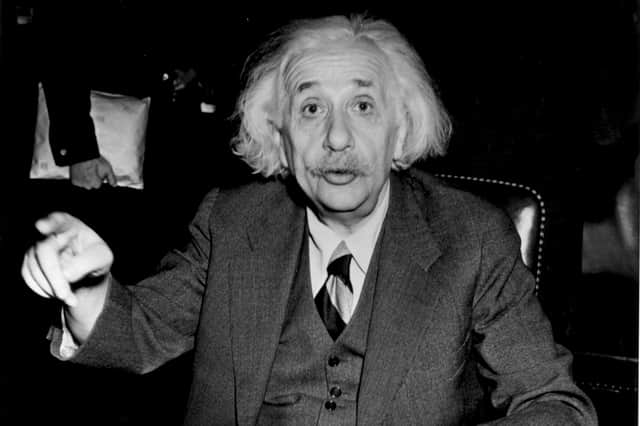What did Einstein invent? Discoveries of genius scientist explained, plus everyday items he helped to create
and live on Freeview channel 276
If you say the name Einstein to anyone, it will likely conjure up images of a crazy haired scientist who speaks with a German accent. He’s also become a recognisable figure in popular culture as he’s inspired many memes thanks to the famous photo of him cheekily sticking his tongue out. He’s also been represented in TV shows, advertisements, books and more. Most recently, he was depicted in the historical biography film Oppenheimer.
The name Einstein is also synonymous with genius for many as he’s considered to be one of the greatest scientists and influential thinkers of all time. But what actually made Einstein a household name which has kept him in the minds of people for generations? Here’s everything you need to know.
Advertisement
Hide AdAdvertisement
Hide AdWho was Albert Einstein?
Albert Einstein was a German-born physicist. He was born on 14 March 1879 and excelled at physics and mathematics from an early age. He soon acquired mathematical expertise and went on to study at the Institute of Technology in Zurich, Switzerland, and received his doctorate at the age of 26 in 1905. It is thought he knew of the problems of physics and always had a determination to solve them. He died on 18 April 1955 at the age of 76.
What did Einstein invent?
Albert Einstein wasn’t what many would call a traditional inventor in that he didn’t create a new product or object. He is most well-known for his theories of relativity which led to new ways of looking at time, space, matter, energy and gravity. His work also inspired important advances including the control of atomic energy, space exploration, and applications of light.
Einstein explained his findings in four groundbreaking papers, which were published in the early 20th century and shaped how people thought about the world around them and the wider universe.


What were Einstein’s four papers?
In 1905, soon after receiving his doctorate, Einstein published four hugely influential scientific papers. The topics were:
Advertisement
Hide AdAdvertisement
Hide Ad- The Brownian movement: Also known as the zigzag motion of microscopic particles in suspension, Einstein's findings in this paper helped to prove the existence of atoms and molecules.
The quantum theory of light: Einstein theorised in this paper that light is composed of separate bundles of energy, called quanta or photons, and these quantum particles have the ability to show wave-like properties. He also explained the photoelectric effect, which is the emission of electrons from some solids when they're struck by light. An example of this would be television.
The link between mass and energy: This paper is where Einstein wrote his famous equation E = mc2, relating to mass and energy. It demonstrates that a small particle of matter contains an enormous amount of energy and this forms the majority of the basis for nuclear energy. This equation is, therefore, widely regarded as the world's most famous equation.
The special theory of relativity: Einstein explained in this paper that time and motion are relative to their observers which means that as long as the speed of light remains constant then natural laws are the same throughout the universe. He also said that nothing can be faster than the speed of light.
What else is Einstein known for?
Einstein received many awards and honours throughout his lifetime, but his most famous achievement was being given the 1921 Nobel Prize in Physics for his services to theoretical physics, especially for his discovery of the law of the photoelectric effect.
In 1939, during World War Two, Einstein sent a letter to President Franklin D. Roosevelt, warning him that Germany could be working on a weapon of tremendous destructive power and urging the United States to create something similar. This advice led to the creation of the Manhattan Project, however, Einstein did not work directly on the atomic bomb project. Instead, fellow scientist J. Robert Oppenheimer took Einstein’s ideas and theories and used them to direct the Manhattan Project scientists to design and test an atomic bomb.
Sixty years later, in 1999, Time magazine named him the Person of the Century, ahead of Roosevelt, among others. The writer stated: "to the scientifically literate and the public at large, Einstein is synonymous with genius".
What everyday items did Einstein help to create?
Einstein may not have directly created any physical items himself, but his discoveries helped to pave the way for many modern inventions which we rely on today. They include:
Clocks
Sat navs
Televisions
Laser devices
Solar panels
Fridges
Comment Guidelines
National World encourages reader discussion on our stories. User feedback, insights and back-and-forth exchanges add a rich layer of context to reporting. Please review our Community Guidelines before commenting.
